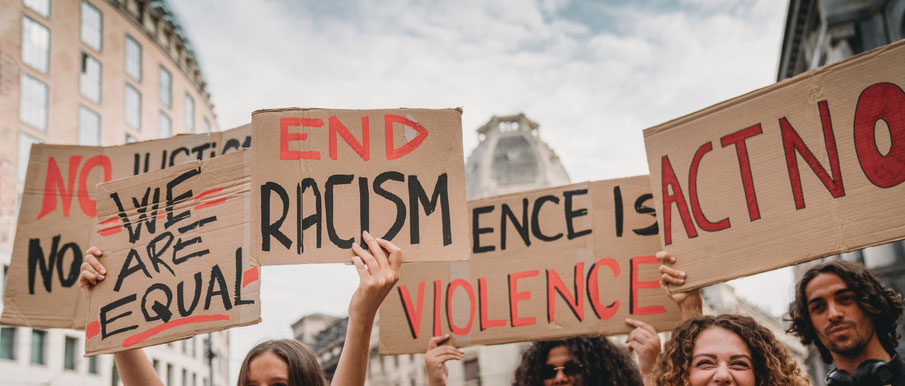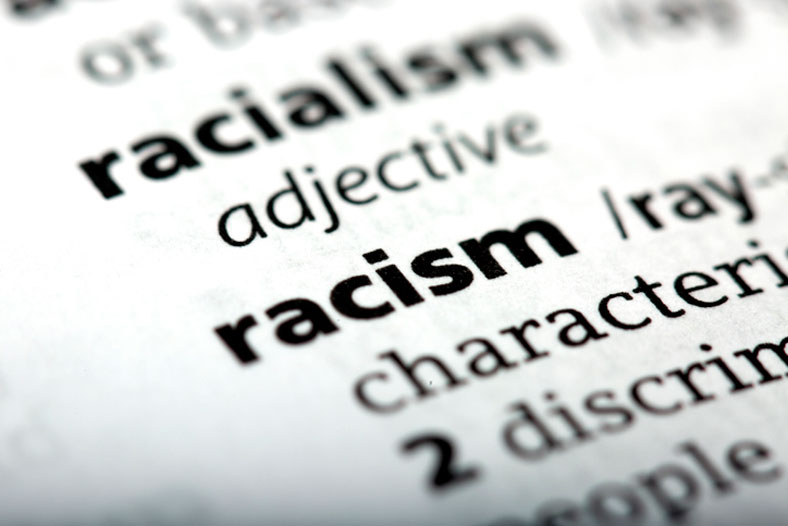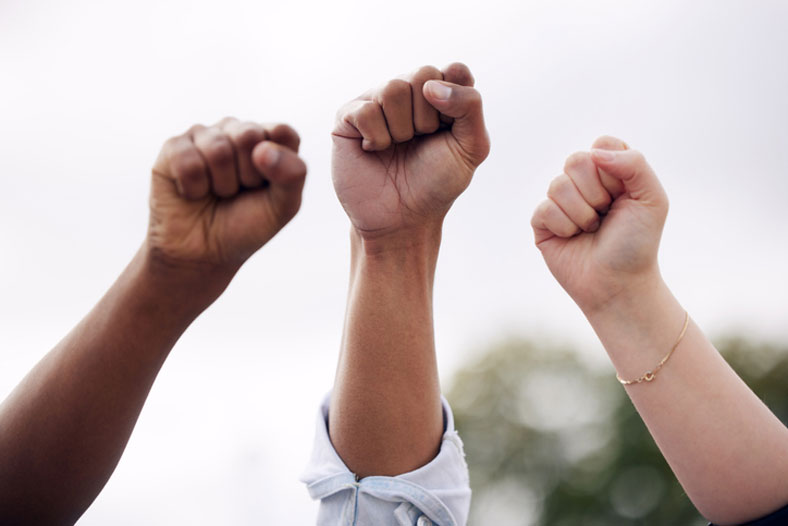As recent years have seen the topic of racial injustice rise once again to the forefront of American politics, social workers can be proud of the role their profession has played throughout the history of this country in fighting for equality and supporting marginalized communities. Indeed, though social workers are involved in a wide range of civic causes, fighting racism is a major part of the legacy of social work dating back from the early 20th century to today.
Sadly, despite the progress that has occurred over the past century, racism and discrimination are widely understood as forces that continue to plague our society. A majority of Americans agree that racism is still a deep problem in the US, one that requires great attention and major institutional overhauls to our current systems in order to achieve a more equitable society. A 2021 Pew Research poll found that 50% of Americans said that “a lot” needs to be done in order to combat racism, with an additional 34% agreeing that at least “a little” needs to be done.

Some social workers are directly engaged with legal and institutional reform, aiming to create sweeping changes that would provide better resources and opportunities for people of color while increasing consequences for racially motivated injustices. Other social workers are focused on on-the-ground responses to racism, providing direct support for individuals and communities who have been overtly or implicitly affected by racist actions and policies.
In fact, combatting racism has been an important part of the social work profession for much of its history. Social workers played a significant role in the Civil Rights Movement of the 1960s, with their advocacy (informed by years of lived experience) deeply shaping the Civil Rights Act of 1964, which integrated all schools, outlawed segregation, and made employment discrimination illegal as well. This is just one of the inspiring causes that social workers have contributed to in changing American society for the better.
To learn more about social workers and racism across American history, different manifestations of racism, and how to get involved in the work of challenging discrimination, read on.
Defining Racism
There are many ways to define racism, as it can exist in many forms. It can be found at the micro level, between individuals and small communities such as workplaces, and at the macro level, on the scale of local, state, and national policy. It can occur “loudly,” in clear conflicts, and it can occur “silently,” as the unspoken context in which one or more racial groups are adversely impacted. It can be targeted at a particular minority group or can broadly impact nonwhite individuals.

How Racism Continues Today
Racism has been a defining force in the development of the United States since its founding, with a legacy that unfortunately still endures in the present day. As we have progressed as a nation, institutional and policy reforms have helped reshape our country to be a land of opportunity for people from all racial backgrounds, but there is much work still to be done.
Read our list below to get a better understanding of the different forms of racism that exist today and what can be done to fight it.
Types of Racism
Racism is an extremely complex problem that can manifest in many different ways. Here are a few of the most widespread examples of discrimination today, with information about the work social workers have done to combat them and spread equality.
Cultural Racism
Cultural racism occurs in instances in which someone is discriminated against, harassed, or otherwise treated unjustly due to their cultural background. This can extend to matters of personal appearance, community activities, religion, and other factors that might not sound like they are explicitly about race on the face of them. However, these are often disguised forms of racism that choose an arbitrary factor – such as, for example, hair, which is a prominent inciting factor for instances of cultural discrimination – as grounds for prejudicial behavior. At other times, individuals do overtly connect certain cultural practices with race to make prejudicial points – e.g., arguing that a particular culture leads individuals to be less successful, etc.
In thinking about the history of social workers and racism, identifying instances of cultural racism and how they impacted people on an individual, community, and national level is one important contribution social workers have made to push for greater societal reforms. Indeed, by working closely with individuals and communities, social workers have often been able to identify and observe phenomena that others hadn’t previously identified specifically as racism. This is an important way that social workers and racism have an intertwined history.
Abstract racism
Cases of abstract racism are when prejudicial or discriminatory assumptions are made about a demographic people in a generalized, stereotypical, and often baseless manner. Explicit instances of abstract racism are often found in communities in which people are not held accountable for racist speech and actions. This is a reminder of the importance of challenging a real life example of discrimination whenever one appears within one’s own community, as it is through enforcing new standards of conduct that people will stop feeling emboldened to spread hateful words and ideas.
Systemic Racism
Another important way that the histories of social work and racism intersect is in fighting against systemic racism. This is another “disguised” form of racism that typically doesn’t manifest as instances of plainly stated racism but rather appears when considering whom is advantaged and disadvantaged by current systems. If one or more minority demographics is adversely affected by a particular system, that is a strong indicator that structural racism is taking place.
One example of systemic racism that has captured significant public attention in recent years is the practice of redlining, which is defined by the Cornell School of Law as “a discriminatory practice that consists of the systematic denial of services such as mortgages, insurance loans, and other financial services to residents of certain areas, based on their race or ethnicity.” Beyond the immediate harm of redlining practices to individual families, many social scientists have observed the long-term, broad-scale harm of redlining to communities who are left stuck in a cycle of poverty, without access to the resources from which one can achieve upward mobility.
In advocating for systemic reforms that will create more equal opportunities and prevent exclusionary practices, social workers have long been champions of equality, challenging discrimination at the level of policy.
Naturalization
Despite the innocuous name, naturalization is a harmful perspective in which racial inequality is perceived as the result of “natural” occurrences. This can include, for example, arguing that segregation is the natural result of people wanting to live near people of the same racial background, ignoring the economic and political factors that created segregation in the first place.
Minimization
Minimization is the destructive attitude that conversations around racial equality are overblown, unnecessary, or unserious. Many have argued that before the Black Lives Matter demonstrations of 2020, national discourse had embraced a position of minimization, failing to adequately address the pressing issues surrounding race. Though the recent years have brought racism back into the spotlight as a plight that still afflicts this country gravely, it is important to stay vigilant about racism to continue to make progress.
One way that social workers and racism can intersect is that social workers can help lead educational initiatives in schools and community centers to raise awareness about issues of racial injustice, helping people to understand that a state of race-based inequality is far from natural, and in fact must be changed.

Addressing Racism
How can social workers meaningfully address the issue of race, challenging discrimination and creating a more just society? There are many different ways that social workers and racism can be brought into conversation toward a more equitable future, from understanding the structural forces behind racism to evaluating one’s own prejudices and perspectives.
Below are a few of the most important ways that social workers can build their knowledge to address and combat racism.
Recognizing Privilege
It’s always important to recognize one’s own privilege, especially in the social work field, in which many social workers are employed within communities that are not their own. Beyond race, there are many factors one can look at to examine their privilege, including the following:
- Gender
- Sexual orientation
- Religion
- Class background
- Level of education
- Citizenship status
Recognizing privilege can be uncomfortable, as it can mean acknowledging some of the unfair advantages one has in our society. When confronting one’s own privilege for the first time, people can experience defensiveness, guilt, or discomfort. However, in doing good for others and pursuing a more equitable society, it’s important to move beyond these feelings so that you can be a more sensitive and informed advocate and resource for those who are disadvantaged.
For this reason, social work course loads frequently begin with taking account of one’s own privilege and how it might inform their perspective.
Institutional Power and Individual Realities
As mentioned above, social work and racism have been historically linked, as social workers have provided a significant amount of useful research in the social sciences, some of which has formed the basis of legal advocacy work. Social workers’ insights have been especially useful in identifying how institutional structures impact disadvantaged demographics.
Because many social workers work directly with individuals and families, one of the important ways that social workers can identify systemic racism is by recognizing patterns and phenomena across client experiences. Oftentimes, social workers work from the micro level to the macro: if individuals from a particular population are going through similar problems, it’s important to look at what institutions are creating the conditions for those problems.
Gatekeeping
Even when there are shared experiences among individuals from a shared demographic, it’s important to be sensitive to the diversity of experiences and perspectives each person has. “Gatekeeping” is the phenomenon by which certain benchmarks are identified that become a kind of qualifying factor to identify within a particular demographic. The truth is, each one of us has a unique perspective that can’t be boiled down to stereotypes. This means that social workers must be open to the individuality of each person they work with, leaving expectations at the door to allow an empathetic engagement to emerge.
Taking History into Account
In understanding the dynamics of race in America, it’s imperative to understand the history of racial oppression in this country. For social workers, it’s especially important to get a grasp on the history of the population you are working with as well as the legacy of the issue in question. For example, if you are doing social work in a hospital or health center, understanding the history of medical racism will help you attend to your patients’ specific needs as well as see where equality still needs to be achieved.
Accountability
In order to continue the legacy of challenging discrimination, it’s crucial that social workers hold one another to the highest standards of inclusivity. (In fact, this is a necessity across professions.) In communities in which there is true accountability, people understand that acts of racism and discrimination are unacceptable.

How Social Workers Are Aiding in the Fight Against Racism
Through American history, social workers have been incredible advocates against racism, challenging discrimination and assisting those who are disadvantaged in our society. Here are just a few of the ways that social workers are addressing systemic racism:
- Developing cultural competence. Social workers have been instrumental in developing the resources by which we can more easily understand the values and cultural practices of communities outside of our own.
- Promoting diversity. From grassroots initiatives to educate communities about racial injustice to nuts-and-bolts policy work to ensure equal opportunity, social workers have been longtime champions of diversity.
- Celebrating historic and cultural leaders. Though the work of facing racial injustice means confronting painful realities, finding sources of pride, inspiration, and joy is critical to finding the motivation to keep fighting and educating younger generations for the future.
- Legislation. Legally-minded social workers can take their insights and observations all the way to the level of policy, advocating for the reforms that will improve the lives of their clients.
Taking the Next Steps to Become a Social Worker
If you’re inspired by the moving history of social workers in the fight against racism, now is the time to take the next steps to become a social worker yourself. Visit our homepage to find more information on a social work career, including educational requirements, job opportunities, salary range and job growth statistics by state, and more. For more information about the impact social workers have had throughout American history, take a look at our article “Why Social Workers Are Important to Society.”



